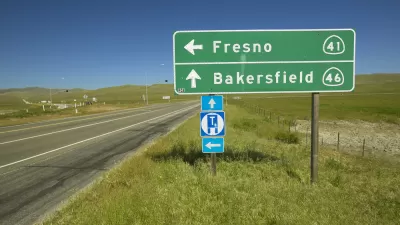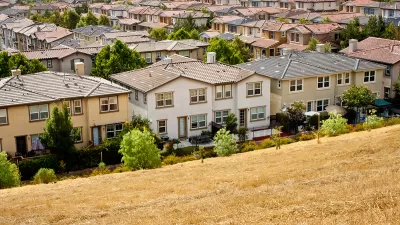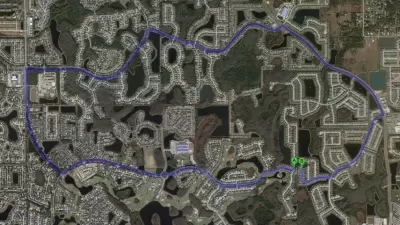Sprawl

Can the Garden Suburb Save the Suburbs?
“Can Paradise be Planned?” asks Allison Arieff in a recent op-ed. The article discusses new books by architect Robert A.M. Stern and photographer Christoph Gielen to look for reasons for optimism with regard to suburbs and planning.

New Research On Smart Growth Benefits
New research indicates that smart growth helps residents become wealthier and healthier.

Urban Planning for Public Health in California’s San Joaquin Valley
The American Lung Association is making an “urban planning push” in three San Joaquin Valley counties, according to a recent article in Associations Now. The idea behind the efforts to reduce public health risks: promote walkable communities.
Why Don’t More Conservatives Support Smart Growth?
A self-identified conservative who supports the “broader vision of smart growth” has identified a reason why more conservatives don’t support smart growth: the political economy of sprawl.
Texas’ Drought Prompts Calls for Water Management Improvements
A recent article details the rapid growth, evaporating surface storage capacity, and manicured lawns worsening drought conditions in Texas (no, not California).

How Not To Measure Housing Affordability
Critics argue that smart growth reduces housing affordability. Their criticisms are partly legitimate and largely wrong, based on incomplete and biased analysis.
Study: Planning Failed the Decaying Suburban Subdivision of Windy Ridge
A new study that examines the contributing and enabling factors that led to high foreclosure rates, neighborhood decline, and disparate impacts on low-income populations in the subdivision of Windy Ridge, near Charlotte, North Carolina.

Study: Sprawl is Bad for Public Health
Smart Growth America has released the "Measuring Sprawl 2014" report, which updates the 2002 report "Measuring Sprawl and Its Impact."
New Development Begs the Question: Which Way, San Jose?
Despite its mostly sprawling conditions, San Jose has recently prioritized walkable, dense urban environments. But should the city focus its development downtown or build a connected network of urban neighborhoods?

SPUR: The Bay Area Has A Sprawl Problem
SPUR states its case clearly by announcing, “We believe cities are the key to our future” at the opening of a new report called “SPUR’s Agenda for Change.”

Drive Till You Disqualify: Will Businesses Continue Hiring Super-Commuters?
Workers with long commutes are more likely to be be tired and stressed at work, and businesses are learning that they often make for less productive employees.
Peak Sprawl Happened—20 Years Ago
Analysis of the USDA’s 2010 National Resources Inventory, which tracks land use, shows the growth rate of suburban sprawl peaking in the mid-1990s, declining by two-thirds since then, even through the most recent housing boom. How did that happen?

The Night That Sprawl Drove Dixie Down
You can point the finger at unprepared politicians or mistaken meteorologists for paralyzing Atlanta this week. But to find the real culprits, you'll have to look at the region's history of land use and transportation decisions, argues Rebecca Burns.
The Creation of a "Drive to Qualify" World
The cost of intown housing makes suburbia fiscally tempting- but this is in part the result of deliberate policy choices by government.
Even Controlling For Poverty, Urban Places Are Thinner Than Suburbs
Poor neighborhoods tend to be fatter than rich ones, whether they are urban or suburban. However, poor urban areas tend to be thinner than poor suburban areas, and rich urban areas tend to be thinner than rich suburban areas.
Exposing Sprawl's Hidden Costs
A new report sheds light on the costs of suburban sprawl that aren't well understood by officials and residents. If more knew the true financial costs they might reconsider their policies and priorities, believes author Dave Thompson.
Effort to Urbanize Las Vegas Hits a Political Wall
In a delicious irony, the Las Vegas City Council has overturned the mixed-use zoning of a parcel in an area planned for more density to make room for a gas station.
Young Candidates Ride Anti-Sprawl Rhetoric to Mayoral Victories in Alberta
On Monday, Calgary elected anti-sprawl crusader Naheed Nenshi to a second term as Mayor. And in Edmonton, 34-year-old Don Iveson, "an up-and-coming hot shot of the same vein of progressive politics", was elected to replace the city's retiring mayor.
Regional Plan Recommends Three Elements for Creating a Thriving Northeast Ohio
Northeast Ohio's largest regional planning effort in a generation recommends infill development, transit expansion, and land conservation as the essential elements for ensuring the area's future success.
Is Atlanta's Shift to Infill Development the Canary in the Sprawl Coal Mine?
A new study indicates that one of America's poster children for auto-centric development has a made a significant u-turn. Since 2009, the majority of Atlanta's new commercial and rental housing has been built in "walkable urban places".
Pagination
Urban Design for Planners 1: Software Tools
This six-course series explores essential urban design concepts using open source software and equips planners with the tools they need to participate fully in the urban design process.
Planning for Universal Design
Learn the tools for implementing Universal Design in planning regulations.
Clanton & Associates, Inc.
Jessamine County Fiscal Court
Institute for Housing and Urban Development Studies (IHS)
City of Grandview
Harvard GSD Executive Education
Toledo-Lucas County Plan Commissions
Salt Lake City
NYU Wagner Graduate School of Public Service


































